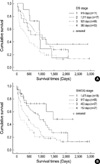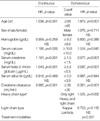1. Durie BG, Salmon SE. A clinical staging system for multiple myeloma. Correlation of measured myeloma cell mass with presenting clinical features, response to treatment, and survival. Cancer. 1975. 36:842–854.

2. Jacobson JL, Hussein MA, Barlogie B, Durie BG, Crowley JJ. Southwest Oncology Group. A new staging system for multiple myeloma patients based on the Southwest Oncology Group (SWOG) experience. Br J Haematol. 2003. 122:441–450.

3. Cuzick J, Cooper EH, MacLennan IC. The prognostic value of serum beta 2-microglobulin compared with other presentation features in myelomatosis. Br J Cancer. 1985. 52:1–6.
4. Alexanian R, Barlogie B, Fritsche H. Beta 2-microglobulin in multiple myeloma. Am J Hematol. 1985. 20:345–351.
5. Scarffe JH, Anderson H, Palmer MK, Crowther D. Prognostic significance of pretreatment serum beta 2-microglobulin levels in multiple myeloma. Eur J Cancer Clin Oncol. 1983. 19:1361–1364.
6. Bataille R, Grenier J, Sany J. Beta-2-microglobulin in myeloma: optimal use for staging, prognosis, and treatment; a prospective study of 160 patients. Blood. 1984. 63:468–476.
7. Cuzick J, De Stavola BL, Cooper EH, Chapman C, MacLennan IC. Long-term prognostic value of serum beta 2 microglobulin in myelomatosis. Br J Haematol. 1990. 75:506–510.
8. Donadio C, Lucchesi A, Ardini M, Giordani R. Cystatin C, beta 2-microglobulin, and retinol-binding protein as indicators of glomerular filtration rate: comparison with plasma creatinine. J Pharm Biomed Anal. 2001. 24:835–842.
9. Jovanovic D, Krstivojevic P, Obradovic I, Durdevic V, Dukanovic L. Serum cystatin C and beta 2 microglobulin as markers of glomerular filtration rate. Ren Fail. 2003. 25:123–133.
10. Bianchi C, Donadio C, Tramonti G, Consani C, Lorusso P, Rossi G. Reappraisal of serum beta2-microglobulin as marker of GFR. Ren Fail. 2001. 23:419–429.
11. International Myeloma Working Group. Criteria for the classification of monoclonal gammopathies, multiple myeloma and related disorders: a report of the International Myeloma Working Group. Br J Haematol. 2003. 121:749–757.
12. Facon T, Avet-Loiseau H, Guillerm G, Moreau P, Genevieve F, Zandecki M, Lai JL, Leleu X, Jouet JP, Bauters F, Harousseau JL, Bataille R, Mary JY. Intergroupe Francophone du Myelome. Chromosome 13 abnormalities identified by FISH analysis and serum beta2-microglobulin produce a powerful myeloma staging system for patients receiving high-dose therapy. Blood. 2001. 97:1566–1571.
13. Greipp PR, Lust JA, O'Fallon WM, Katzmann JA, Witzig TE, Kyle RA. Plasma cell labeling index and beta 2-microglobulin predict survival independent of thymidine kinase and C-reactive protein in multiple myeloma. Blood. 1993. 81:3382–3387.







 PDF
PDF ePub
ePub Citation
Citation Print
Print







 XML Download
XML Download